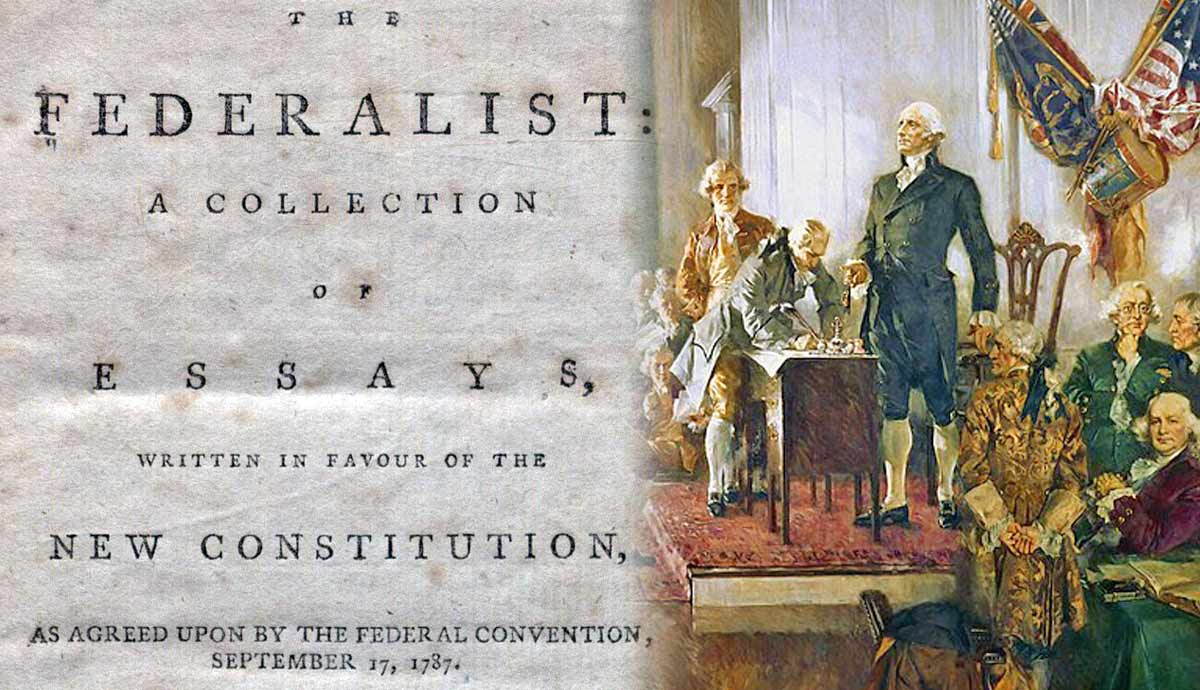
When it became evident that the Articles of Confederation no longer protected the new United States of America, the Founding Fathers met in Philadelphia to draft a new Constitution, the supreme law of the land that granted the federal government unprecedented powers. The Founders knew the nation needed it, but would their states and constituents agree? To help with their decision, the supporters of the Constitution published 85 essays touting its principles: the Federalist Papers.
Background and Purpose

The Philadelphia Convention of 1787 overextended its mandate to improve the Articles of Confederation, which governed the young nation in a loose confederation of independently powerful states. Most Americans still feared a strong centralized power like Britain, which they had sacrificed so much fighting against less than a decade prior.
The Articles had created a weak central government with limited powers, one unable to regulate commerce, levy taxes, or provide for national defense. The Constitution that the men created in Philadelphia would remedy all those issues and more, yet, to do so, they had to develop a strong central government that was not much different from Britain. However, where it had a king, the US would have a president. Where England had the Parliament, the US would have a Congress. Considering the newly independent Americans’ loathing of the British, this would be a hard sell.
When the Philadelphia Convention ended, the representatives set off to their respective states to campaign for the new document’s ratification. The argument for or against it began almost instantly. The debate transcended gossip and spilled over from state legislatures to mass meetings, newspaper columns, and tavern brawls.
Those who supported the passage of the stronger Constitution called themselves the Federalists, and those who opposed it were the Anti-Federalists. At the core of the discussion was the new political blueprint for a still-young nation. The Constitution introduced a new framework that called for three branches of government (legislative, executive, and judicial), a system of checks and balances to prevent the branches’ abuse of power, separation of powers between the federal and state governments, a bicameral legislature which would create the laws of the land, and an amendment process to help adopt the document over time. Ultimately, all the points would be analyzed, defended, and attacked.
Federalists vs. Anti-Federalists

The name “Federalists” was specifically chosen as it stemmed from the word “federalism,” which meant a division of power, in this case, between the state and federal government. The key Federalists, Alexander Hamilton, James Madison, and John Jay, hoped that the name would ease some of the worries of those afraid of an all-encompassing federal government. The men and those like them found their support in large landowners, merchants, and farmers living close to coastal trade centers, all of whom looked forward to a more regulated economy with tariff protections against foreign goods.
The opponents, most prominent of whom were Patrick Henry and Samuel Adams, were most concerned about whether the state governments or the federal government would have more say in the law-making process. Many Anti-Federalists were small Western farmers living far from the coast who considered themselves self-made men and distrusted wealthy and powerful Eastern elites.
On February 15, 1788, The Massachusetts Gazette printed a typical anti-Constitution feeling when it quoted a farmer named Amos Singletary:
“These lawyers and men of learning, and moneyed men, that talk so finely, and gloss over matters so smoothly, to make us poor, illiterate people swallow down the pill, expect to get into Congress themselves; they expect to be managers of this Constitution and get all the power and all the money into their own hands, and then they will swallow up us little folks.”
Amid the contentious debate, the Federalists turned to their talented trio of Hamilton, Madison, and Jay to influence public opinion and persuade the undecided delegates to support ratification. Collectively known as the Federalist Papers, the 85 essays were first aimed strictly at the New York constituents but later reprinted all over the Union, becoming a crucial tool for the Constitution’s supporters.
Publication and Impact

The Federalists published their essays in New York newspapers under the pseudonym “Publius” to focus readers’ attention on their content, not their author. The city, chosen for its strong anti-Federalist sentiment, was important for its economic and political importance—with the idea that if New York ratified the Constitution, the other states would surely follow.
While they were all written on different topics, the Federalist Papers mainly addressed four main concerns the Constitution’s opponents raised. One of the more famous essays, Federalist 51, written by James Madison, addressed the built-in checks and balances between the three branches of government to ensure a proper balance of power and prevent any of them from becoming too powerful.
The question of the new federal government’s potential for infringing on the citizen’s individual rights was a non-issue, the Papers’ authors argued, as the system would not only check its own abuses but the Constitution could be amended, opening a door for a descriptive Bill of Rights that would protect the desired liberties.
Highlighting the need for a strong central government, the Federalist 23, written by Hamilton, highlighted the issues of defense, trade, and taxation under the current Articles of Confederation. It argued how a government that could tax its people could use those funds to build an adequate armed force to protect its borders, as well as build up the nation’s infrastructure to help stimulate domestic trade.
Legacy of the Federalist Papers

In perhaps the most famous of the essays, Federalist 10, James Madison tackled the problem that he saw as a significant threat to the republican system of government now being proposed: factions. Madison defined factions as groups of citizens, either the majority or the minority, that use their influence to take advantage of others or push policies that benefit themselves at the expense of the common good.
Federalist 10 argued that only a large and diverse republic could act as the best defense against factions. According to Madison, with more people with a broader range of interests, it becomes virtually impossible for any one faction to gain enough influence, forcing different interests toward a compromising table. This was before the creation of political parties, news media, and even the more recent social media, where voices could come together in mere moments and grow into the very factions or movements that Madison feared would destroy the republic.
While the Federalist Papers did not immediately sway public opinion toward ratification, they provided enough food for thought regarding the new government’s structure. Ultimately, the Constitution’s ratification did just fine without New York leading the way, which was the 11th state to ratify it on July 26, 1788.
The promise of adding a Bill of Rights, the first ten amendments to the Constitution protecting individual liberties from federal government’s abuses, finally tipped the scales in the Constitution’s favor. Yet, in the context of the published essays, for modern scholars and citizens alike, the Federalist Papers now offer unprecedented insights into the Founding Fathers’ intentions and the foundational principles of the American political system.










